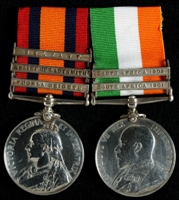

Queen's South Africa Medal with clasps 'Tugela Heights', 'Relief of Ladysmith', 'Belfast'; King's South Africa Medal with clasps 'South Africa 1901', 'South Africa 1902'
Unfortunately we don't know this man's first name or anything about his early life or family.
He joined the Manchester Regiment in around October 1890 and was given the service number 3010. We don't know anything about his career until August 1899, when he was serving with the 1st Battalion in Gibraltar. In that month the British Government decided to send the battalion to South Africa in case war broke out between British and Boer settlers there.
The battalion was stationed in the small town of Ladysmith when war was declared on the 11th October. The war began badly for the British and by the end of the month Ladysmith was under siege.
The 1st Battalion was trapped in the town, but this soldier was not. At some point before the siege began he was assigned to Number 12 Bearer Company of the Royal Army Medical Corps. This unit's role was to find and recover wounded men from the battlefield and bring them to medical units for treatment.
This man took part in British efforts to break the siege of Ladysmith. He was involved in the Battle of the Tugela Heights between the 14th and 27th February 1900. During this battle the British were finally able to drive the Boer forces off their positions on the high ridges and hills near Ladysmith. This allowed the British to advance safely towards the town. Faced with this defeat, the Boers retreated and the siege was lifted on the 28th.
This man then rejoined the 1st Battalion and fought with them during the rest of the war. After Ladysmith the British Army tried to force the Boers to face it in battle. They succeeded on the 21st August 1900 at the Battle of Belfast, or Bergendal. He took part in this battle, which lasted until the 27th and ended with the defeat of Boer forces and the capture of their temporary capital, Machadodorp (today called eNtokozweni). The Boers did not surrender; they fought on as guerrillas in small units, so this man stayed in South Africa.
There were no battles on the same scale during the rest of the war. The 1st Battalion took part in many smaller operations intended to restrict the Boer's movements and force them to face British soldiers. This strategy was eventually successful and the war came to an end on the 31st May 1902.
At some point after this he was sent home and transferred to the Army Reserve. This had happened by June 1903. As a Reservist he was free to find a home and a job, but could be called back to the Army in an emergency. Where he lived, and everything else about the rest of his life, remains a mystery. His medals were donated to the Museum of the Manchester Regiment in August 1949.




